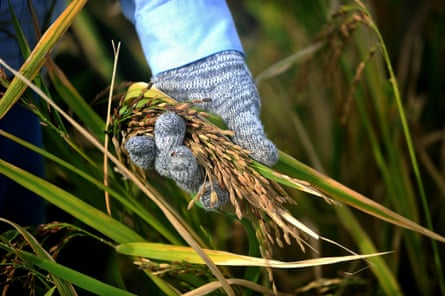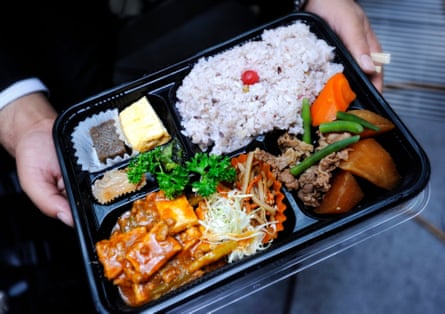Back to brown: how a shift away from refined white rice could cut diabetes | Global health
A plan to develop a new breed of iron-rich rice that could ward off disease was swiftly abandoned by Dr Sirimal Premakumara after he ventured into the countryside of Sri Lanka – and found it already existed.
The secret to injecting more nutrition into the common diet, he discovered, were already there in the varieties of rice the country’s farmers had been growing for centuries.
So instead of researching new breeds, the University of Colombo lecturer has spent the past 10 years studying the brown, purple, red and glutinous varieties of rice still grown in small amounts by farmers in Sri Lanka, despite being almost forgotten as the market demanded piles of cheap white rice.
Rice statistic
High yield white rice has been crucial to fighting global hunger, but its reputation is coming into question with concerns about its nutritional deficiencies and its links to type 2 diabetes.
Premakumara has so far documented 300 types of rice with anti-diabetic, anti-inflammatory and antioxidant properties that could be developed for wider consumption. “It was the farmers who saved these traditional grains. We call it medicinal rice because they claimed it was like medicine, and we just wanted to verify those claims,” says Premakumara, who focuses on Sri Lanka but fears that Asia as a whole has lost thousands of varieties through the industrialisation of rice farming over the past century.
A woman cooking biryani in West Bengal, India. Rice-based dishes are a staple of people’s diets throughout Asia. Photograph: Majority World/REX/Shutterstock
Rice is a staple of diets across Asia, where 90% of the world’s rice is produced and 78kg is eaten each year per capita – more than double any other region – according to the UN’s Food and Agriculture Organization. In Cambodia, Laos and Bangladesh, it provides the main source of carbohydrates and protein because so little else is consumed by the average person.
But white rice, which has been milled and polished to remove the nutrient-rich outer layers, is now closely associated with the continent’s growing problem with diabetes. The International Diabetes Foundation predicts that, by 2045, diabetes will affect about 152 million people in south-east Asia, which includes India, Bangladesh and Sri Lanka, up from 35 million in 2000, and 260 million people in the western Pacific region, as classified by the IDF, which includes China, Japan and Thailand, up from 44 million 20 years ago.
Projected diabetes cases
Dr Vasanti Malik, Canada research chair in nutrition and chronic disease prevention at the University of Toronto, says her research shows that eating two or three servings of white rice a day increases the chances of developing diabetes by 16%, compared with eating smaller amounts. White rice, she says, is quickly absorbed because it lacks fibre and other micronutrients, prompting rapid spikes of blood glucose and insulin levels which, over time, increase the risk.
Quick Guide
Why is rice so important?
Show
Rice is the world’s most consumed grain and is a staple food for more than half the world’s population. About 90% comes from Asia; the continent eats far more of it than anyone else, with many countries stocking up to ensure people don’t go hungry.
Which countries consume the most?
In south Asia, rice constitutes up to 70% of people’s calorie intake. Bangladesh eats the most, with the average person consuming 266kg a year – compared with 8kg in the UK – according to the UN’s Food and Agriculture Organization. Laos, Cambodia, Vietnam and Indonesia consume more than 200kg per capita each year. In Africa, demand is growing 6% a year, driven by population growth, urbanisation and changing tastes, says the Africa Rice Center.
What rice do people eat?
People now mostly eat white rice, which became popular in the 1960s. It is produced by a milling process that removes the nutrients of brown rice, contributing to an increase in health conditions such as diabetes, say researchers. Thousands of traditional rice varieties are no longer grown because farmers have been encouraged to plant high-yield breeds of white rice.
Thank you for your feedback.
“What has changed is that rice has become increasingly processed, lifestyle has become more sedentary and the combination of sedentary lifestyle and consumption of refined carbohydrates is particularly detrimental for diabetes risk,” she says.
Everyone is told to grow the same rice and it’s destroying farmers. They are now nutritionally deficientShailesh Awate
Less-refined brown rice, she adds, contains more fibre and magnesium that lower the risk of diabetes in a rice-heavy diet.
Shailesh Awate, co-founder of OOO Farms, a social movement in India, is encouraging farmers to switch back to older varieties. He travels around India, Sri Lanka and the Philippines collecting seeds that can be stored and offered to other farmers. “If you look now in India, every nutritionist is bashing rice and telling people it’s bad for health, starchy, bad for fat and heart problems, but they forget that [people in] India and China have eaten rice for thousands of years and they were never weak,” he says.
“Everyone is told to grow the same rice and it is destroying farmers. They are now nutritionally deficient and have to eat more of these new rices because the stomach doesn’t understand quantity, it understands nutrition.”
New “improved” rice varieties emerged in the 1960s as a way to produce more food. Technological innovations became known as the green revolution and included the creation of high-yield “miracle rice” that allowed countries to become self-sufficient. Over the past year, the ability to produce and store it in large amounts has helped rice prices remain stable while other staples such as wheat and corn fluctuate because of shipping disruptions caused by the Ukraine war.

But while hailed as a successful tool for tackling food insecurity, the focus on high-yield rice has resulted in the loss of traditional varieties, say campaigners, and, with that, the knowledge of the benefits they bring.
“It was such a misleading term to market these new seeds as ‘improved’ because it suggested what people were eating before was underdeveloped,” says Awate. Traditional varieties not only had their own nutritional benefits but were also adapted to their specific environments, he adds, unlike the new breeds developed by research institutes, which demand more fertilisers and insecticides and can require farmers to buy new seeds each year rather than recycling their old crop.
Sign up to Global Dispatch
Get a different world view with a roundup of the best news, features and pictures, curated by our global development team
Privacy Notice: Newsletters may contain info about charities, online ads, and content funded by outside parties. For more information see our Privacy Policy. We use Google reCaptcha to protect our website and the Google Privacy Policy and Terms of Service apply.
“Before 1965, farmers were scientists. Their fields were their labs. Now, they are just labourers, working to feed my stomach and the banks,” says Awate.
According to John Cavanagh, the former director of the Institute for Policy Studies, the shift to white rice began late in the 19th century, when powered rice mills from Japan accelerated the previously laborious process of separating the inedible outer husk of rice grains. But these machines also polished the grain so much they removed the bran and turned brown rice, which was the most commonly consumed variety at the time, into white.
The polished grain could be stored for longer and was more easily shipped because it was less likely to rot or be eaten by insects, opening the way for increased trade in the early 20th century. Being quicker to cook and easier to digest helped to convert rice-consuming populations more used to the taste of brown rice.

Even before diabetes became one of Asia’s most pressing health concerns, the removal of fibre and nutrients through polishing had affected the health of populations with rice-heavy diets. A vitamin deficiency known as beriberi, which affects the nerves, became so common in India that by the 1940s doctors were calling for milled rice to be banned.
According to Cavanagh, during the second world war US prisoners who were fed only white rice had to convince their Japanese captors to be allowed to cook their rations with shavings of rice bran because beriberi was so common.
Cavanagh said it was not known at the time that milling and polishing rice would remove key nutrients. Now that it is, there needs to be a return to traditional methods. “What’s driving it back is diabetes. Doctors have realised white rice is fuelling an explosion of diabetes and are telling people to go back to brown,” he says.
Switching back is both necessary and possible, he believes. It would, however, require a market shift because mills are set up to focus on white rice. Yet the actual processing of the brown variety is cheaper and quicker, and polishing is no longer required to extend its shelf life because of better packaging.

Convincing rice-eating populations to shift away from the addictive qualities of refined white rice may be more difficult, but Cavanagh says people changed their tastes a century ago, so can change them back.
Awate adds that the economics of food production needs to change. “We have broken the nutrition of people in the cities and have played with the farmer’s economics so badly that he will sell his fresh rice and buy something that has been stored for seven years in warehouses,” he says. “They are nutrition deficient even after eating so much. The food on their plate is so bad.
“We focus on yield per acre, but if you go by nutrition by acre, then the country doesn’t have to worry about food security.”
No Byline Policy
Editorial Guidelines
Corrections Policy
Source
